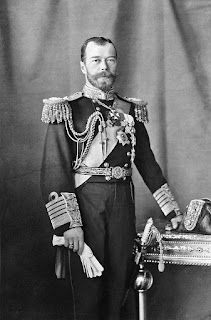The Russian Revolution was a pair of revolutions in Russia
in 1917, which dismantled the Tsarist autocracy and led to the eventual rise of
the Soviet Union. The Russian Empire collapsed with the abdication of Emperor
Nicholas II, and the old regime was replaced by a provisional government during
the first revolution of February 1917 (March in the Gregorian calendar; the
older Julian calendar was in use in Russia at the time). In the second
revolution that October, the Provisional Government was removed and replaced
with a communist state.
The February Revolution (March 1917) was a revolution
focused around Petrograd (now Saint Petersburg), then capital of Russia. In the
chaos, members of the Imperial parliament or Duma assumed control of the
country, forming the Russian Provisional Government. The army leadership felt
they did not have the means to suppress the revolution, resulting in Nicholas'
abdication. The Soviets (workers' councils), which were led by more radical
socialist factions, initially permitted the Provisional Government to rule, but
insisted on a prerogative to influence the government and control various
militias. The February Revolution took place in the context of heavy military
setbacks during the First World War (1914–18), which left much of the Russian
Army in a state of mutiny.
A period of dual power ensued, during which the Provisional
Government held state power while the national network of Soviets, led by
socialists, had the allegiance of the lower classes and the political left.
During this chaotic period there were frequent mutinies, protests and many
strikes. When the Provisional Government chose to continue fighting the war
with Germany, the Bolsheviks and other socialist factions campaigned for
stopping the conflict. The Bolsheviks turned workers militias under their
control into the Red Guards (later the Red Army) over which they exerted
substantial control.
In the October Revolution (November in the Gregorian
calendar), the Bolsheviks, led by Vladimir Lenin, and the workers' Soviets
overthrew the Provisional Government in Petrograd and established the Russian
SFSR, eventually shifting the capital to Moscow in 1918. The Bolsheviks
appointed themselves as leaders of various government ministries and seized
control of the countryside, establishing the Cheka to quash dissent. To end
Russia’s participation in the First World War, the Bolshevik leaders signed the
Treaty of Brest-Litovsk with Germany in March 1918.
Soon after, civil war erupted among the "Reds"
(Bolsheviks), the "Whites" (counter-revolutionaries), independence
movements and non-Bolshevik socialists. It continued for several years, during
which the Bolsheviks defeated both the Whites and all rival socialists. In this
way, the Revolution paved the way for the creation of the Union of Soviet
Socialist Republics (USSR) in 1922. While many notable historical events
occurred in Moscow and Petrograd, there was also a visible movement in cities
throughout the state, among national minorities throughout the empire and in
the rural areas, where peasants took over and redistributed land.
Credits: Wikipedia |
| Bolshevik forces marching on the Red Square |

